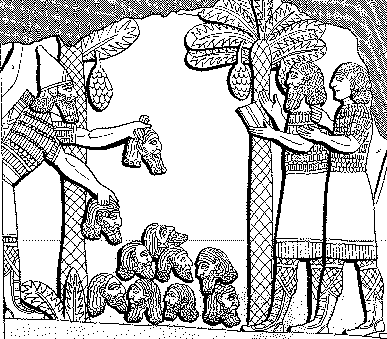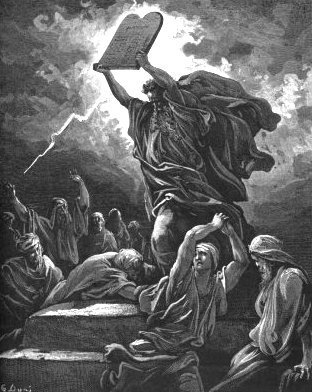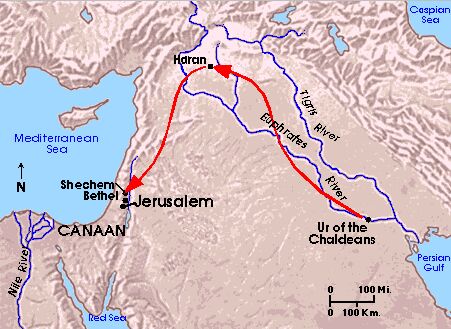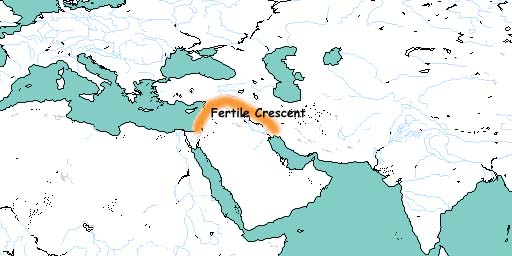Ancient Mesopotamia Test Quiz!

This quiz will help you review for our Unit 8 Ancient Mesopotamia test!
- 1.
A ziggurat would be an example of which trait of civilization?
- A.
Government
- B.
Social classes
- C.
Monumental architecture
- D.
Stable food supply
Correct Answer
C. Monumental architectureExplanation
A ziggurat is a type of ancient Mesopotamia with stepped sides. "Monumental" means "large" and "architecture" means "buildings." A ziggurat would have been the largest building in an ancient Mesopotamian city or city-state.Rate this question:
-
- 2.
Agriculture is most closely connected to which trait of civilization?
- A.
Stable food supply
- B.
Trade
- C.
Monumental architecture
- D.
Social classes
Correct Answer
A. Stable food supplyExplanation
"Agriculture" means farming and raising animals for food. Once people invented agriculture, they no longer needed to hunt and gather their food. Therefore, agriculture created a stable food supply.Rate this question:
-
- 3.
Which trait of civilization means "groups of people who have different jobs, and different rights"?
- A.
Trade
- B.
Government
- C.
System of writing
- D.
Social classes
Correct Answer
D. Social classesExplanation
A "class" means a "group." Some examples of social classes today are rich people and poor people.Rate this question:
-
- 4.
To which trait of civilization is cuneiform most closely related?
- A.
System of writing
- B.
Monumental architecture
- C.
Government
- D.
Stable food supply
Correct Answer
A. System of writingExplanation
"Cuneiform" means "triangle shaped" in Greek, and it is used to describe the world's earliest writing system, invented by the ancient Sumerians. Cuneiform writing was made using a reed stylus on clay tablets.Rate this question:
-
- 5.
What is a word for "belief in many gods"? (SPELLING COUNTS)
Correct Answer
polytheism
Polytheism
polytheistic
PolytheisticExplanation
In Greek, "poly" means "many," and "theo" means "god." The ancient Sumerians were polytheistic. They believed in wind gods, moon gods, and all kinds of other gods.Rate this question:
- 6.
A(n) ___________ is bigger and harder to govern than a(n) ________________.
- A.
Irrigation...empire
- B.
Empire...irrigation
- C.
City-state...empire
- D.
Empire....city-state
Correct Answer
D. Empire....city-stateExplanation
A city-state is a city that is also its own country. An empire is a large area where many groups of people are ruled by a single government. Would you rather rule a city-state, or an empire, and why?Rate this question:
-
- 7.
Which empire is known for its cruelty, harshness and skill at warfare?
- A.
Sumerians
- B.
Persians
- C.
Assyrians
- D.
Babylonians
Correct Answer
C. AssyriansExplanation
The Assyrians are known for their cruelty, harshness, and skill at warfare. They were a powerful empire in ancient Mesopotamia and were feared by many neighboring civilizations. The Assyrians were notorious for their brutal military tactics, including the use of psychological warfare, mass deportations, and the destruction of entire cities. They were highly skilled in siege warfare and developed advanced military technologies such as battering rams and siege towers. The Assyrians were ruthless conquerors and their empire was built on a foundation of fear and intimidation.Rate this question:
-
- 8.
What ancient Mesopotamian empire began in the country that is today called "Iran"?
- A.
Akkadian Empire
- B.
Assyrian Empire
- C.
Babylonian Empire
- D.
Persian Empire
Correct Answer
D. Persian EmpireExplanation
The ancient name for Iran is "Persia."Rate this question:
-
- 9.
This empire used a tolerant style of government and built a large system of roads. Some of its kings were Cyrus and Darius.
- A.
Akkadian Empire
- B.
Assyian Empire
- C.
Babylonian Empire
- D.
Persian Empire
Correct Answer
D. Persian EmpireExplanation
The Persian Empire is the correct answer because it fits the description provided. The Persian Empire was known for its tolerant style of government, allowing conquered peoples to retain their own customs and religions. They also built an extensive network of roads, known as the Royal Road, which facilitated communication and trade throughout the empire. Cyrus and Darius were both famous kings of the Persian Empire.Rate this question:
-
- 10.
This picture probably shows the
- A.
Sumerians
- B.
Assyrians
- C.
Persians
Correct Answer
B. AssyriansExplanation
The Assyrians were known for their harsh rule. When they conquered a city-state, they would kill or enslave its people.Rate this question:
-
- 11.
This Jewish leader freed the Hebrews from slavery in Egypt and wrote down the Ten Commandments (Type David, Abraham, Solomon, or Moses. Spelling counts!)
Correct Answer
Moses
mosesExplanation
Moses is the correct answer because he is a Jewish leader who freed the Hebrews from slavery in Egypt and wrote down the Ten Commandments. He is a significant figure in Jewish history and is known for leading the Israelites out of Egypt during the Exodus. Moses is also credited with receiving the laws and commandments from God on Mount Sinai, which he then recorded in the form of the Ten Commandments.Rate this question:
- 12.
Which Jewish leader left the city-state of Ur with his family, creating one of the first monotheistic religions? (type David, Solomon, Abraham, or Moses. Spelling counts!)
Correct Answer
Abraham
abrahamExplanation
Because of this, Abraham is called the "father of Judaism" and Judaism, Christianity and Islam are all called "Abrahamic religions" because they all believe Abraham was an important founder.Rate this question:
- 13.
Why did people decide to move from the Zagros Mountains to the river plains of Mesopotamia many thousands of years ago?
- A.
Because there were no rivers in Mesopotamia.
- B.
Because the land there was fertile.
- C.
Because they were nomads and had to keep moving.
- D.
Because they formed the first empire.
Correct Answer
B. Because the land there was fertile.Explanation
Having a stable food supply helped people form the world's first civilization - Sumer. A stable food supply meant that people had a surplus, so they could start to develop different jobs, trade things, build large buildings, and develop all the traits of a civilization!Rate this question:
-
- 14.
Which of these would NOT be an example of a law from Hammurabi's Code?
- A.
If a man breaks the bone of a man of his own social class, his bone shall be broken.
- B.
Do not make any statues or carved images of any gods.
- C.
If a man breaks the bone of a poor man, he shall pay him 3 month's wages in silver.
- D.
If you are caught stealing from a house or a temple, you shall be put to death.
Correct Answer
B. Do not make any statues or carved images of any gods.Explanation
B is part of the ten commandments. The Babylonians, and other Mesopotamian empires, were polytheistic and made many statues of their gods. A, C, and D are part of the Code of Hammurabi -- one way to tell is their harsh consequences.Rate this question:
-
- 15.
David and Solomon were
- A.
Jewish or Hebrew kings
- B.
Sumerian Kings
- C.
Egyptian kings
- D.
Assyrian Kings
Correct Answer
A. Jewish or Hebrew kingsExplanation
David and Solomon were Jewish or Hebrew kings. This is because both David and Solomon are prominent figures in the Hebrew Bible, specifically in the Old Testament. David is known for establishing Jerusalem as the capital of Israel and for his military victories, while Solomon is known for his wisdom and for building the First Temple in Jerusalem. Both David and Solomon played significant roles in the history of the Jewish people, making them Jewish or Hebrew kings.Rate this question:
-
- 16.
Why did Sumerians become good farmers?
- A.
They developed irrigation systems.
- B.
They passed their land from father to son.
- C.
They lived in the hills.
- D.
They developed new types of crops.
Correct Answer
A. They developed irrigation systems.Explanation
The Sumerians became good farmers because they developed irrigation systems. Irrigation allowed them to control and distribute water to their crops, ensuring a reliable water supply for agriculture. This improved their ability to grow crops and increased their agricultural productivity. By efficiently managing water resources, the Sumerians were able to cultivate more land and produce surplus food, leading to economic prosperity and development in their civilization.Rate this question:
-
- 17.
The Ten Commandments and the Code of Hammurabi are both
- A.
Records about the economy
- B.
Sets of laws
- C.
Religious rules
- D.
Ways to spread monotheism
Correct Answer
B. Sets of lawsExplanation
The Ten Commandments and the Code of Hammurabi are both sets of laws. The Ten Commandments are a set of religious and moral laws given by God to the Israelites, while the Code of Hammurabi is a set of laws created by the Babylonian king Hammurabi to govern his empire. Both sets of laws provide guidelines and regulations for society, covering various aspects of life such as property rights, family law, and criminal justice. They serve as important historical documents that reflect the legal systems and societal norms of their respective time periods.Rate this question:
-
- 18.
This is the beginning of the Code of Hammurabi:"… The gods Anu and Enlil … named me by my name: Hammurabi, who worships the gods, to bring justice to the land, to get rid of the wicked and the evil, to prevent the strong from oppressing the weak, to rise like the sun-god Shamash over all..."This passage shows that Hammurabi
- A.
Belonged to a polytheistic religion.
- B.
Belonged to the Persian Empire.
- C.
Belonged to a monotheistic religion.
- D.
Belonged to the Assyrian Empire.
Correct Answer
A. Belonged to a polytheistic religion.Explanation
The passage mentions at least three gods: Anu, Enlil, and Shamash. Polytheism means "a belief in many gods." Monotheism means "a belief in only one god."Rate this question:
-
- 19.
What was the name of the Mesopotamian writing system?
- A.
The Alphabet
- B.
The Code of Hammurabi
- C.
Hieroglyphs
- D.
Cuneiform
Correct Answer
D. CuneiformExplanation
Cuneiform was the name of the Mesopotamian writing system. It was developed by the ancient Sumerians around 3500 BCE and was used by various civilizations in Mesopotamia, including the Babylonians and Assyrians. Cuneiform was composed of wedge-shaped marks made on clay tablets using a reed stylus. It was one of the earliest known writing systems and played a crucial role in recording and preserving information, such as laws, literature, and historical events, in ancient Mesopotamia.Rate this question:
-
- 20.
Judaism was different from other ancient Mesopotamian religions because
- A.
The Jews believed in many gods.
- B.
The Jews had no written text.
- C.
The Jews prayed indoors.
- D.
The Jews were monotheistic.
Correct Answer
D. The Jews were monotheistic.Explanation
Monotheistic means they believed in only one god. The rest of the Mesopotamians believed in many gods.Rate this question:
-
- 21.
This picture shows:
- A.
Moses receiving the Code of Hammurabi
- B.
Abraham receiving the Ten Commandments
- C.
Hammurabi receiving the Code of Hammurabi
- D.
Moses receiving the Ten Commandments
Correct Answer
D. Moses receiving the Ten CommandmentsExplanation
This picture depicts Moses receiving the Ten Commandments. In the biblical story, Moses is said to have received the Ten Commandments directly from God on Mount Sinai. The image likely portrays this significant moment in which Moses is presented with the tablets containing the commandments, symbolizing the covenant between God and the Israelites.Rate this question:
-
- 22.
What happened to the Jews in Egypt?
- A.
They became rich
- B.
They became slaves
- C.
They became powerful
- D.
They became monotheistic
Correct Answer
B. They became slavesExplanation
Slavery was common in the ancient world.Rate this question:
-
- 23.
These are laws from the Code of Hammurabi:"15. If any one takes someone else's slave outside the city gates, he shall be put to death. 16. If any one houses a runaway slave, the master of the house shall be put to death. 17. If any one finds runaway slaves in the open country and brings them back to their masters, the master of the slaves shall pay him two shekels of silver."These laws show that:
- A.
People in the ancient world did not have social classes.
- B.
Slavery was common in the ancient world.
- C.
Slaves had a high social class.
- D.
Hammurabi's Code treated everyone equally.
Correct Answer
B. Slavery was common in the ancient world.Explanation
The laws from the Code of Hammurabi indicate that slavery was common in the ancient world. This is evident from the fact that there were specific laws addressing the treatment and control of slaves. The laws mentioned in the question highlight the severe consequences for taking someone else's slave outside the city gates or housing a runaway slave, indicating the value placed on slave ownership and the measures taken to maintain control over them. Additionally, the provision for returning runaway slaves and the payment of silver to the person who brings them back further emphasizes the prevalence of slavery in ancient societies.Rate this question:
-
- 24.
This map shows:
- A.
Conquests of Hammurabi
- B.
The journey of Moses out of Egypt
- C.
The journey of Abraham to Canaan
- D.
How Sumer began
Correct Answer
C. The journey of Abraham to CanaanExplanation
Abraham is called the "father" of the Jews because he moved his family to Canaan so they could practice their religion freely.Rate this question:
-
- 25.
The best name for the place shown in this drawing is:
- A.
Empire
- B.
State
- C.
City-state
- D.
City
Correct Answer
C. City-stateExplanation
A city-state is a small country with its own laws and government, that is made up of a city and farms.Rate this question:
-
- 26.
The fertile crescent is significant because it was the site of the
- A.
Invasion of Kuwait by Iraq
- B.
Development of early civilizations
- C.
Establishment of global trade
- D.
First World War
Correct Answer
B. Development of early civilizationsExplanation
The fertile crescent is significant because it was the site of the development of early civilizations. This region, located in the Middle East, was one of the first areas where agriculture and settled communities emerged. The fertile soil and access to water from the Tigris and Euphrates rivers allowed for the cultivation of crops, leading to the establishment of farming communities. These communities eventually developed into complex societies with advanced technologies, such as writing systems and organized governments. The fertile crescent is often referred to as the "cradle of civilization" due to its pivotal role in the development of human society.Rate this question:
-
Quiz Review Timeline +
Our quizzes are rigorously reviewed, monitored and continuously updated by our expert board to maintain accuracy, relevance, and timeliness.
-
Current Version
-
Mar 21, 2023Quiz Edited by
ProProfs Editorial Team -
Mar 03, 2010Quiz Created by
Ms.sutherland
 Back to top
Back to top







